Mohamed Elkabbani1,2*, Akram Hammad1, Mohammed Hammad1, Ahmed Mostafa Saied1, Bassam Ali Abouelnas1, Michael Schulte2
1Department of Orthopaedic Surgery, Faculty of Medicine, Mansoura University, 25. El Gomhouria St, 35516, Mansoura, Dakahlia Governorate, Egypt
2Department of Orthopaedics and Traumatology, Agaplesion Diakoniekllnikum Rotenburg, Germany
*Corresponding Author: Mohamed Elkabbani, MD, Department of Orthopaedic Surgery, Faculty of Medicine, Mansoura University, 25. El Gomhouria St, 35516 Mansoura, Dakahlia Governorate, Egypt;
Email: [email protected]; [email protected]
Published Date: 22-06-2022
Copyright© 2022 by Elkabbani M, et al. All rights reserved. This is an open access article distributed under the terms of the Creative Commons Attribution License, which permits unrestricted use, distribution, and reproduction in any medium, provided the original author and source are credited.
Abstract
Aim: The objective of this study was to evaluate the intermediate term clinical and radiological results of a Bone preserving short stem hip implant being operated through a minimally invasive anterolateral hip approach.
Methods: In 20 consecutive patients suffering from osteoarthritis with 25 affected hip joints (five cases were bilateral), the clinical and radiological results of 25 hip arthroplasties performed in one hospital between October 2009 and May 2014 through a minimally invasive anterolateral approach using a cementless short stem prosthesis type Aida and a cementless cup type Ecofit with a ceramic-on-ceramic pairing were evaluated prospectively. The median age of patients at time of surgery was 60 years (range, 42-71 years), 15 male (4 were bilateral) and 5 female patients (one was bilateral) were included in the study. The median clinical follow up was 30 months (range, 2-88 months) and the median radiological follow up was 30 months (range, 2-88 months).
Results: Harris Hip Score improved from a median preoperative value of 53 to a median postoperative value of 96 (range, 73-100) at follow up. 22 hips (88%) showed an excellent postoperative Harris Hip Score, 2 hips (8%) a good postoperative Harris Hip Score and one hip (4%) a fair postoperative Harris Hip Score. Only two patients complained of postoperative thigh pain. Regarding patient satisfaction, 15 patients (60%) were very satisfied, 10 patients (40%) were satisfied. None was unsatisfied. Radiological analysis showed that 19 stems (76%) were with stable bony ingrowth, two cases (8%) showed stable fibrous ingrowth. Four cases need further follow up for proper evaluation of stem fixation.
Conclusion: The intermediate term survival of the Aida short stem hip implant being operated through a minimally invasive anterolateral hip approach is very promising and achieving the goals of a standard hip arthroplasty.
Keywords
Minimally Invasive; Anterolateral Approach; Short Stem; Hip Arthroplasty
Introduction
Total hip replacement is a common and successful orthopedic procedure (operation of the century) [1]. However, being increasingly applied to younger patients, several complications appeared in long-term follow-up studies especially the problems related to progressive bone resorption.
Early traditional stem type cementless implants obtained strong fixation distally. However, this was associated with thigh pain and the distal off-loading predisposed to stress shielding with loss of proximal bone stock and subsequent osteolysis and loosening. All these complications decreased the life span of these protheses in young patients requiring multiple subsequent revisions.
Arthroplasty of the hip replacement is more concerned recently about reduced bone and soft tissue aggression. This new philosophy “tissue sparing surgery” resulted in new conservative hip implants components as an alternative to conventional stems [2].
Accordingly, several issues are driving the development of conservative hip implants including the desire to optimize the loading of the proximal femur and to preserve bone stock especially in young patients, as well as the increasing popularity of minimally invasive surgery.
Conservative hip arthroplasty using short metaphyseal stems is gaining importance because the number of young patients is on the increase and hip resurfacing is not always indicated. Short metaphyseal stems attempt to bridge the gap between straight stem implant design and hip resurfacing.
Materials and Methods
A series of 25 hip arthroplasty surgeries in 20 patients (five bilateral patients) who received Aida® hip stem (implantcast, Buxtehude, Germany) and Ecofit® acetabular cup (implantcast, Buxtehude, Germany) with ceramic-on-ceramic pairing between October 2009 and May 2014 in one hospital were followed prospectively. At time of surgery, median age was 60 (range, 42-71) years, median clinical follow up was 30 (range, 2-88) months, with median radiological follow up of 30 (range, 2-88) months. Only patients with body mass index of less than 30 kg/m2 were selected, in addition to adequate bone density (as determined by stable rasp fit) and no history of hip fractures, or surgeries. The median body mass index was 25.8 (range, 20.7-30). Accordingly, 15 male and 5 female patients were included in the study (5 cases with dysplastic hips and 20 cases with arthritic hips). Informed consent was obtained from all the patients.
Thirteen hips received the lateralized offset stem variant (CCD angle of 125°) and 12 hips received the standard offset stem variant (CCD angle of 130°). A cementless Ecofit cup (50-58 mm in diameter) with a ceramic liner and ceramic large head (36 mm) (Biolox, Ceramtec, Germany) was used in each case. Acetabular cup screws were required for additional implant stability in one case.
The EcoFit® cup is made of TiAl6V4-Titanium wrought alloy with pure titanium coating. With a pressfit cementless basis, its triradial design offers rigid acetabular cup seating.
The Aida® hip stem is a cementless short stem type which preserves proximal femoral metaphyseal bone and available in 9 sizes each with two different available offsets (standard offset with 130° CCD angle; lateralized offset with 125° CCD angle). It is made of TiAl6V4-titanium alloy with a 12/14 mm taper and a proximal dual coating of pure titanium and hydroxyapatite and with a polished distal part.
Surgery was done under supervision of the senior Author in the same hospital. MediCAD® digital planning software was used for Preoperative templating. All patients were placed in lateral position using a vacuum mattresses Olympic Vac-Pac® system for surgical positioning and confirming the proper pelvis positioning by fluroscopy. Minimally invasive anterolateral OCM approach of the hip was used in all cases followed by femoral head resection while preserving the femoral neck lateral aspect [3].
Femoral intramedullary canal was then cleared with a specific curved awl till reaching the lateral femoral cortex, then canal preparation follows with the supplied broaches. The aim was bone impaction rather than removal and finally stem insertion through a press-fit cementless technique.
Weight bearing of 20-30 kg was allowed postoperatively for 6 weeks. Clinical evaluation was done using Harris Hip Score in addition to thigh pain whether present or absent as well as patient satisfaction [4]. This evaluation was done preoperatively and at last postoperative visit. In addition, Patient satisfaction was recorded either very satisfied, satisfied, or unsatisfied (Fig. 1-3).

Figure 1: Aida short stem, Implantcast, Germany.

Figure 2: Intraoperative broaching of the femoral canal with special awl and rasp.

Figure 3: Intraoperative broaching of the femoral canal with special awl and rasp.
Furthermore, for the evaluation of the minimally invasive anterolateral OCM approach, blood loss, hospital stay length, incision length, postoperative analgesia, operative time (skin to skin) and intraoperative complications were recorded.
X-rays were done postoperatively and at last follow-up visit, then compared against each other. All Measurements were done digitally by two independent experienced orthopedic surgeons specializing in hip arthroplasty. Interobserver variations were recorded and discrepancies were resolved by consensus. Radiographs were evaluated for stem angulation, presence or absence of radiolucent lines, subsidence, osteolysis (femoral or acetabular), heterotopic ossification and bone remodeling and stress-shielding.
Subsidence was measured by taking the average of two measurements: the first is the distance between the lateral stem neck shaft junction and trans-ischeal line and the second measurement is the distance between the lower stem tip and the uppermost part of the lesser trochanter. Stem angulation was assessed by measuring the angle between the femoral shaft axis and a line parallel to the lower straight lateral part of the stem in the anteroposterior X-ray view. All X- rays were taken in the same hospital and with the hip in 15° of internal rotation.
Syngo® medical imaging software (Siemens, Germany) was used for performing all measurements. Radiolucent lines were allocated to Gruen zones 1-7 [5]. Osteolysis was defined as localized bone resorption areas. Femoral bone remodeling was evaluated according to Gruen zones. Heterotopic ossifications were graded according to Brooker classification [6].
Full clinical data were collected directly in 14 cases (58%) and by telephone questionnaire in 8 cases (33 %) (Table 1).
Variable | Value |
Gender: Male Female | 15 patient (19 hip) 5 patient ( 6 hip) |
Side affected: Right Left | 15 hips 10 hips |
Age | 60 years (42-71 years) |
Body weight | 80 kg (57-107 kg) |
Height | 173 cm (165-192 cm) |
Body mass index | 25.8 kg/m2 (20.7-31 kg/ m2) |
Table 1: Demographic data of the patients.
Results
Radiological Results
Stable bony ingrowth occurred in Nineteen Aida stems (76%), stable fibrous ingrowth occurred in two cases (8%). One case showed equivocal signs and close follow up was recommended, as Harris Hip Score was 97 and there was no thigh pain. Further follow up was needed in three hips as there was not enough radiological evidence stem ingrowth.
Biological stem fixation was assessed according to Engh, et al., (stable bony ingrowth fixation, stable fibrous fixation and unstable stems) [7].
Calcar rounding off and atrophy was seen in 11 cases and was not considered a sign for stress shielding. 4 cases showed 5 mm subsidence and three cases showed no measurable subsidence, with the remaining cases showing subsidence values in-between. One case showed stage II Heterotopic ossification according to Brooker. Femoral or acetabular osteolysis were not radiologically evident in any case (Fig. 4,5).

Figure 4: Preoperative radiographs of a patient with Rt. Dysplastic hip.

Figure 5: Postoperative 51 months follow-up radiographs of the same patient with Rt. Dysplastic hip.
Clinical Results
Median Harris Hip Score value improved from a preoperative value of 53 to 96 at follow up (median 30 months), 22 hips (88%) showed an excellent postoperative Harris Hip Score, 2 hips (8%) a good postoperative Harris Hip Score and one hip (4%) a fair postoperative Harris Hip Score.
15 patients (60%) were very satisfied, 10 patients (40%) were satisfied. None was unsatisfied. Two patients complained of mild to moderate postoperative thigh pain.
Skin to skin operating time was 99 minutes (median value, range, 70-238 minutes). In Five patients centrally acting analgesics were prescribed in addition to the routinely used NSAIDs and paracetamol.
HHS Group | Preoperative No. of hips (%) | Last Follow-up No. of hips (%) |
Excellent (90-100) | 0 (0%) | 22 (88%) |
Good (80-89) | 0 (0%) | 2 (8%) |
Fair (70-79) | 1 (4%) | 1 (4%) |
Poor (<70) | 24 (96%) | 0 (0%) |
Table 2: Preoperative and last follow-up total HHS.
Hemoglobulin values preoperatively were 14.3 gm/dl (median value), however this value dropped to 11.3 gm/dl (median value) in the first post operative day and further to 10.8 gm/dl (median value) in the 2nd postoperative day. Blood transfusion postoperatively was needed only in two patients. Intraoperative complications were femoral cortex perforation (one case) requiring no additional treatment and femoral neck fissuring or fracture (3 cases), being treated with cerclage wiring and non weight bearing. Leg length discrepancy was between 0.4 and 2 cm in 14 cases. Skin incision length was 9 cm (median value range, 7-12 cm). Postoperative hospital stay was 10.5 days (median value range, 7-18 days).
Postoperative complications included one case with pulmonary embolism, two cases with prolonged wound discharge and one case with early postoperatively dislocation during the first month that was treated by closed reduction and bracing. There was no complication requiring revision surgery (Fig. 6).

Figure 6: Preoperative digital planning of Aida hip (CFP prosthesis in the other side), Patient positioning, Confirmation of accurate lateral positioning by fluoroscopy and the incision for OCM minimally invasive anterolateral approach.
Discussion
Hip joint replacement is performed more frequently in younger patients nowadays, as a result long-term bone stock preservation is becoming increasingly mandatory. Periprosthetic bone loss, caused by differential load distribution and subsequent stress shielding around the hip stem leads to late implant failure. Short-stemmed femoral components are designed to keep the physical loading in the proximal part of the femur to reduce stress shielding.
Results of standard cementless taper-design stems in young patients are less favorable compared to older and less active patient populations [8]. With indications not markedly different from conventional total hip replacement, short stem hip arthroplasty are usually indicated for young patients to justify the need for such more expensive hip implants.
The Aida hip stem design follows the design of the Mayo hip (developed in 1980 in Mayo clinic, Rochester, USA and used since 1985) and is aiming at cementless proximal metaphyseal fixation. With a circumferential proximal coating of pure titanium and hydroxyapatite -instead of the fiber metal mesh coating of the Mayo stem, The Aida stem is available in 9 sizes, each with two different offsets (instead of only 4 available sizes with fixed CCD angle of 132 degree in case of Mayo hip). In addition, a thinner proximal part and thicker distal part than the Mayo hip, minimizes the risk of intraoperative fractures during implantation of the Aida stem. The distal polished part of the Aida stem is for proper stem alignment during implantation, not for achieving any distal diaphyseal fixation. In addition, the implant tip acts like an implantation guide aligning itself in the proximal diaphysis.
The anterolateral approach OCM (Orthopaedische Chirurgie Muenchen) was firstly described by H. Roettinger, as a modification of the conventional Watson-Jones technique which is done with the patient in lateral position. He used the intermuscular interval between the abductors and the tensor fascia lata, thus preserving the abductors and their function after THA without increased incidence of posterior dislocation, as the posterior capsule and muscles are intact [3].
In the literature, Mayo hip showed 98% survival rate, after 6 years (mean value) of follow up [9]. Another study by Hube, et al., showed markedly better early functional results with the Mayo-hip than those of standard cementless stems [10]. Similarly, other short stems showed good results at short term follow up as in Snyder et al. study about the Metha stem [11].
Few studies, however investigated the long-term results of short stem hip arthroplasty as Pipino, et al., study about CFP prostheses with a follow-up time of 13 to 17 years which showed excellent or good clinical results in only 82% [12].
Another study assessed the long-term outcomes of Ultra-short metaphyseal-fitting anatomic cementless femoral stem (Proxima; DePuy, Leeds, United Kingdom) in 239 consecutive series of patients younger than 50 years old. Because of the excellent long-term clinical and radiographic results, the study concluded that initial theoretical concerns about early aseptic loosening due to the absence of distal stem fixation were not justified [13].
Mumme in 2013 performed a clinical study on the Aida stem (Implantcast, Buxtehude, Germany) with a reported survival rate of 97% in 35 hips with a mean follow-up of 15 months [14].
High load distribution on the calcar region of the femur is important to ensure long term survival of short stems [15,16]. A recent systematic literature search concluded that short stems could preserve proximal bone stock and have slightly less proximal bone loss in the first years, compared to anatomic stems. A total of 29 studies on bone mineral density in short and anatomic hip stems were included [17].
Our results are comparable to those mentioned in the literature. However, the weakness of this study is the relative low number of patients included in the study as well as relatively short follow-up. However as most of these short stems are new in the market, this is a general limitation of their studies.
Conclusion
The intermediate term survival of the Aida short stem hip implant being operated through a minimally invasive anterolateral hip approach is very promising and achieving the goals of a standard hip arthroplasty. Its design has shown that preservation of proximal bone stock without affecting stem stability is possible allowing subsequent revisions with primary implants rather than long revision stems.
Conflict of Interest
The authors verify that there is no conflict of interest.
References
- Learmonth ID, Young C, Rorabeck C. The operation of the century: Total hip replacement. Lancet. 2007;370(9597):1508-19.
- Falez F, Casella F, Panegrossi G, Favetti F, Barresi C. Perspectives on metaphyseal conservative stems. J Orthopaed Traumatol. 2008;9:49-54.
- Rottinger H. Minimally invasive anterolateral approach for total hip replacement (OCM Technique). Oper Orthop Traumatol. 2010;22:421-30.
- Harris WH. Traumatic arthritis of the hip after dislocation and acetabular fractures: treatment by mold arthroplasty. An end-result study using a new method of result evaluation. J Bone Joint Surg Am. 1969;51(4):737-55.
- Gruen TA, McNeice GM, Amstutz HC. “Modes of failure” of cemented stem-type femoral components: a radiographic analysis of loosening. Clin Orthop. 1979;141:17-27.
- Brooker AF, Bowerman JW, Robinson RA, Riley LH. Ectopic ossification following total hip replacement: incidence and a method of classification. J Bone Joint Surg Am. 1973;55:1629-32.
- Engh CA, Bobyn JD, Glassman AH. Porous-coated hip replacement. The factors governing bone ingrowth, stress shielding and clinical results. J Bone Joint Surg Br. 1987;69(1):45-55.
- Malchau H, Herberts P, Eisler T, Garellick G, Soderman P. The Swedish total hip replacement register. J Bone Joint Surg Am. 2002;84-A (Suppl 2):2-20.
- Morrey BF, Adams RA, Kessler M. A conservative femoral replacement for total hip arthroplasty. A prospective study. J Bone Joint Surg Br. 2000;82(7):952-8.
- Hube R, Zaage M, Hein W, Reichel H. Early functional results with the Mayo-hip, a short stem system with metaphyseal-intertrochanteric fixation. Orthopäde. 2004;33:1249-58.
- Synder M, Drobniewski M, Pruszczynski B, Sibinski M. Initial experience with short Metha stem implantation. Orthop Traumatol Rehabil. 2009;11(4):317-23.
- Pipino F, Molfetta L, Grandizio M. Preservation of the femoral neck in hip arthroplasty: results of a 13- to 17-year follow-up. J Orthopaed Traumatol. 2000;131-9.
- Kim YH, Park JW. Long-term outcomes of ultra-short metaphyseal-fitting anatomic cementless femoral stem in total hip arthroplasty with ceramic-on-ceramic articulation for young patients. J Arthroplasty. 2019;34(10):2427-33.
- Mumme T. AIDA. In: Kurzschaftendoprothesen. Wo liegen die Unterschiede (Ed. Jerosch J). Cologne: Deutscher Aerzte-Verlag GmbH. 2013:109-11.
- Parchi PD, Cervi V, Piolanti N, Ciapini G, Andreani, L Castellini, et al. Densitometric evaluation of periprosthetic bone remodeling. Clin Cases in Mineral and Bone Metabolism. 2014;11(3):226-31.
- Bostian PA, Grisez BT, Klein AE, Frye BM. Complex primary total hip arthroplasty: small stems for big challenges. Arthroplast Today. 2021;8:150-6.
- De Waard S, Van der Vis J, Venema PAHT, Sierevelt IN, Kerkhoffs GMMJ, Haverkamp D. Short-term success of proximal bone stock preservation in short hip stems: a systematic review of the literature. EFORT Open Rev. 2021;6(11):1040-51.
Article Type
Research Article
Publication History
Received Date: 25-05-2022
Accepted Date: 14-06-2022
Published Date: 22-06-2022
Copyright© 2022 by Elkabbani M, et al. All rights reserved. This is an open access article distributed under the terms of the Creative Commons Attribution License, which permits unrestricted use, distribution, and reproduction in any medium, provided the original author and source are credited.
Citation: Elkabbani M, et al. Minimally Invasive Anterolateral Approach Total Hip Arthroplasty Using Bone Preserving Short Femoral Stem: Intermediate Term Clinical and Radiological Results. J Ortho Sci Res. 2022;3(2):1-12.
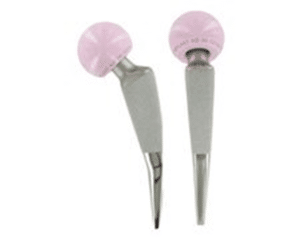
Figure 1: Aida short stem, Implantcast, Germany.
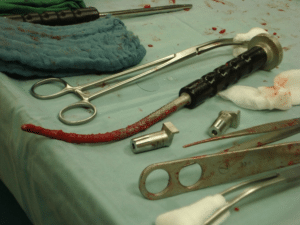
Figure 2: Intraoperative broaching of the femoral canal with special awl and rasp.
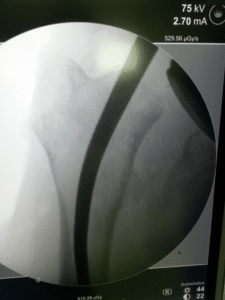
Figure 3: Intraoperative broaching of the femoral canal with special awl and rasp.
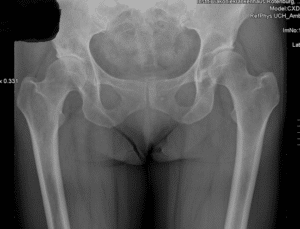
Figure 4: Preoperative radiographs of a patient with Rt. Dysplastic hip.
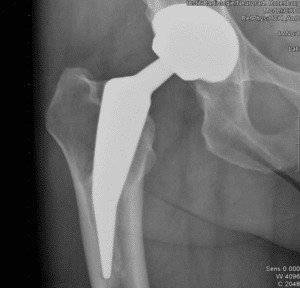
Figure 5: Postoperative 51 months follow-up radiographs of the same patient with Rt. Dysplastic hip.

Figure 6: Preoperative digital planning of Aida hip (CFP prosthesis in the other side), Patient positioning, Confirmation of accurate lateral positioning by fluoroscopy and the incision for OCM minimally invasive anterolateral approach.
Variable | Value |
Gender: Male Female |
15 patient (19 hip) 5 patient ( 6 hip) |
Side affected: Right Left |
15 hips 10 hips |
Age | 60 years (42-71 years) |
Body weight | 80 kg (57-107 kg) |
Height | 173 cm (165-192 cm) |
Body mass index | 25.8 kg/m2 (20.7-31 kg/ m2) |
Table 1: Demographic data of the patients.
HHS Group | Preoperative No. of hips (%) | Last Follow-up No. of hips (%) |
Excellent (90-100) | 0 (0%) | 22 (88%) |
Good (80-89) | 0 (0%) | 2 (8%) |
Fair (70-79) | 1 (4%) | 1 (4%) |
Poor (<70) | 24 (96%) | 0 (0%) |
Table 2: Preoperative and last follow-up total HHS.


